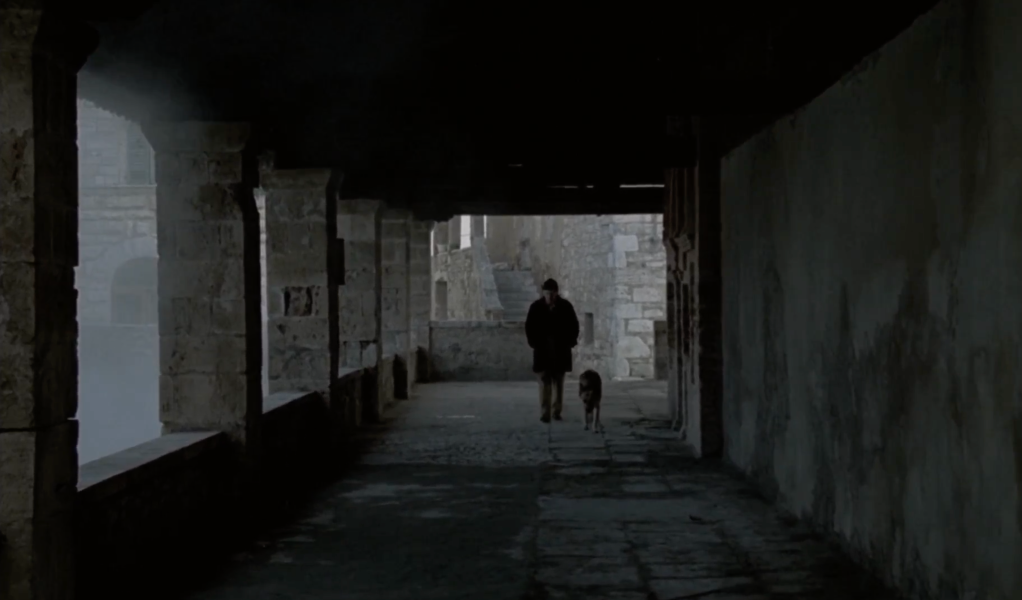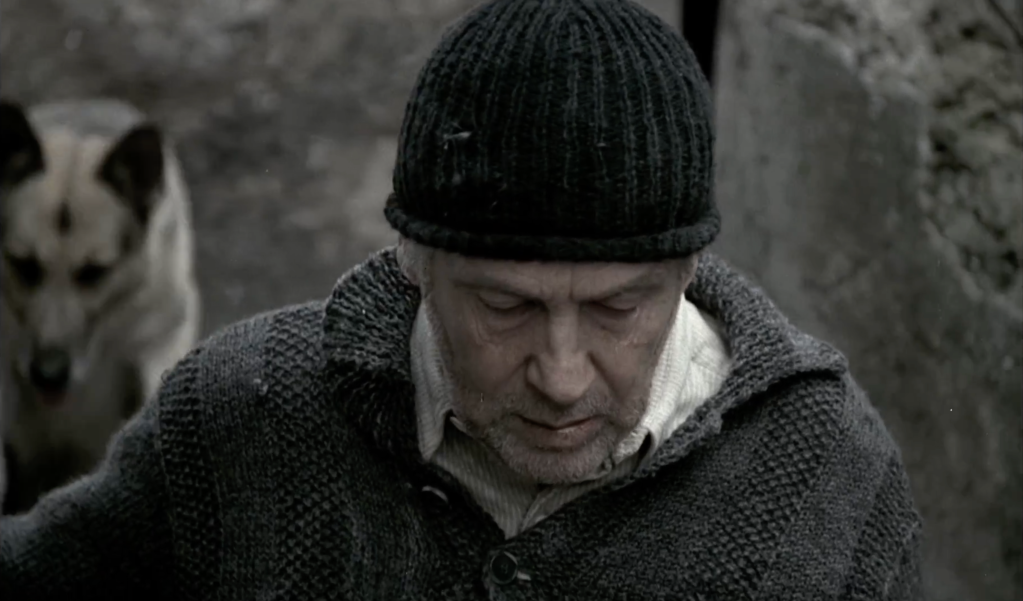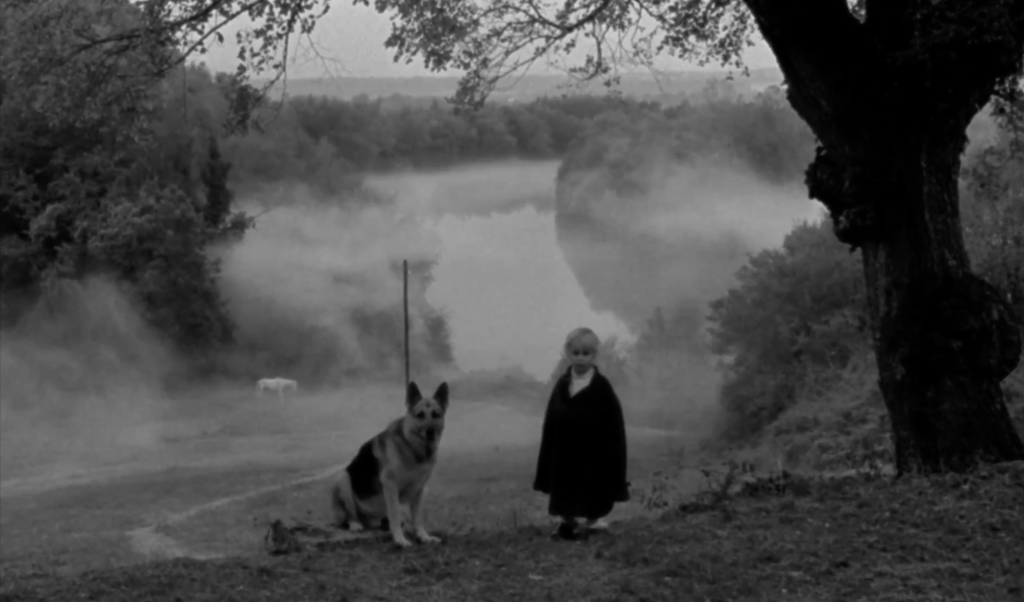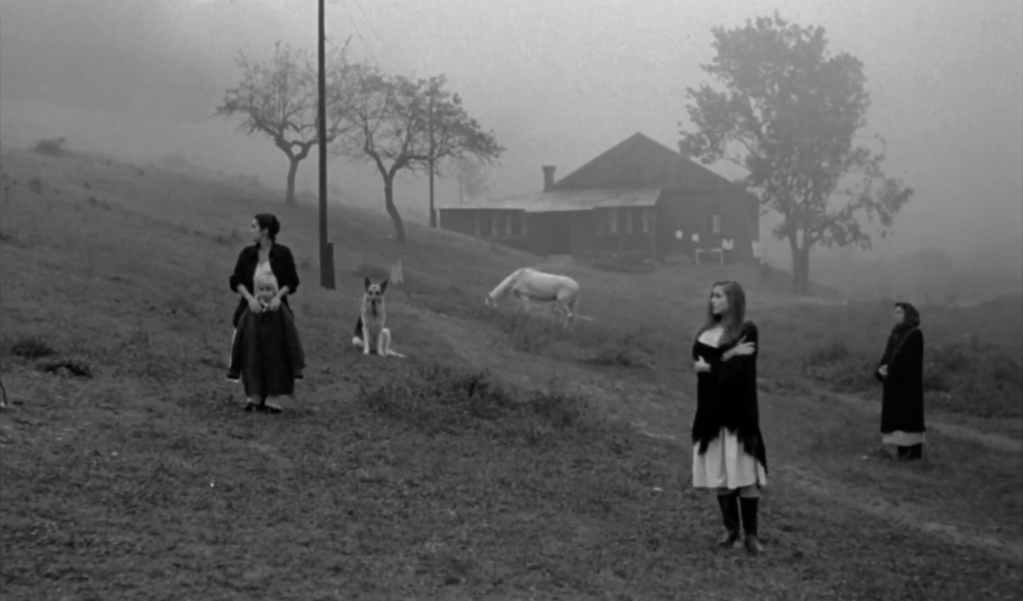Tarkovsky’s Dogs: 1+1=1
Nostalghia, 1983: A dark room. The sound of rain. Andrei on a hotel bed. A German shepherd appears from the bathroom and walks to his side, knocking over a cup as she settles on the floor. A pool of rainwater grows on the tile. Andrei reaches to pet the dog.

Nostalgia: nostos (homecoming, homeward journey), algia (forming nouns denoting types of pain, typically in the location or of the nature specified by the first element).1
Formed of two Greek roots, nostalgia did not originate in ancient Greece. As Svetlana Boym puts it, “Nostalgia is only pseudo-Greek, or nostalgically Greek.”2 A Swiss medical student, Johannes Hofer, sutured the term together in 1688 in his Dissertatio Medica de Nostalgia.3 The term is medical rather than poetic in origin. Those first diagnosed with the affliction included the “various displaced people of the seventeenth century, freedom-loving students from the Republic of Berne studying in Basel, domestic help and servants working in France and Germany and Swiss soldiers fighting abroad.”4 Luckily for these early patients, the disease was not thought to be fatal. Remedies included: “leeches, warm hypnotic emulsions, opium and a return to the Alps.” For those suffering from nostalgia, one of the first symptoms is the appearance of a loved one in dreams.5
Nostalgia has since shed its medical trappings and become enmeshed in poetics. Boym writes extensively about the term in The Future of Nostalgia and draws a distinction between reflective and restorative nostalgia. Boym writes,
Restorative nostalgia stresses nostos and attempts a transhistorical reconstruction of the lost home. Reflective nostalgia thrives in algia, the longing itself, and delays the homecoming—wistfully, ironically, desperately. Restorative nostalgia does not think of itself as nostalgia, but rather as truth and tradition. Reflective nostalgia dwells on the ambivalence of human longing and belonging and does not shy away from the contradictions of modernity. Restorative nostalgia protects the absolute truth, while reflective nostalgia calls it into doubt.6
Tarkovsky is a nostalgiac of both orders. The Tarkovsky we meet in Mirror has elements of the restorative. He reconstructed the dacha of his childhood. He resurrected the farmstead from photographs on the original foundations on which it stood.7 When he took his mother to visit, “The house awoke in her the feelings which the film intended to express…”8 There is a particularly vivid anecdote Tarkovksy tells about the buckwheat field in front of the house. He writes, “The white flowers, which give the effect of a snow-covered field, have stayed in my memory as one of the distinctive and essential details of my childhood.”9 When he arrived in the village to scout locations, there was no buckwheat to be found. Instead, the kolkhoz were growing clover and oats.10 The filmmaker asked the farmers if they could sow the field with buckwheat, but they insisted it was not possible. Committed to rebuilding the mythical site of memory, Tarkovsky rented the field and planted buckwheat despite the farmer’s warnings. It flowered. Tarkovsky reflects, “It seemed to tell us something about the special quality of our memory—about its capacity for penetrating beyond the veils drawn by time, and this was exactly what the film had to be about: it was a seminal idea.”11 This type of nostalgiac—the restorative—“believe that their project is be about truth.”12
The Tarkovsky we meet in Nostalghia is a nostalgiac veering closer to the reflective than the restorative. The film was released two years before he announced that he would not return to the Soviet Union. The film follows a Russian writer, Andrei Gorchakov, on his travels in Italy. He is researching Pavel Sosnovsky, a fictional 18th century Russian composer who lived in Italy and committed suicide upon his return to Russia. Sosnovsky and Gorchakov both suffer from a severe case of nostalgia. Gorchakov’s case and Tarkovsky’s treatment of it are both reflective. Boym writes, “Reflective nostalgia does not present to rebuild the mythical place called home; it is ‘enamored of distance, not of the referent itself.’ This type of nostalgic narrative is ironic, inconclusive, and fragmentary.”13 Gorchakov does not call his wife, though she appears to him in dreams. He does not leave Italy. He drinks and reads poetry and “lingers on ruins, the patina of time and history, in the dreams of another place and another time.”14 He is enamored with the destructive power of algia.
Etymologically, it appears that nostalgia is about a lost sense of place. It is a journey home that is the source of pain. Tarkovsky, living and working in Italy, seems to be nostalgic for Russia. However, nostalgia is really a longing for another time.15 The journey home is grounded in memory, embedded in the past. The place itself is somewhere impossible. The experience of nostalgia is inseparable from the cruel forward march of time. That is the tragedy. Tarkovsky is sensitive to this, revisiting the memories of his childhood across his filmography. He treats these dreams and memories with a peculiar rhythm. I noted this style before regarding Ivan’s Childhood. It is Schrader’s slow cinema.
The moment from Nostalghia that holds my punctum is the second-most notable long take from the film. The take lasts four minutes. It is a wide, static shot that shows Andrei in his hotel room. He has just closed the door on his translator and traveling companion Eugenia. He throws the book she gave him against the wall. The room is sparse. He sets down his suitcase and turns off all the lights. He opens the shutters; it is raining. The camera lingers with Andrei as he sits on the edge of the bed, in the dark, listening to the rain. He takes off his shoes and coat, then falls into the mattress. There is no urgency to these actions, only lethargy. The camera slowly probes closer, deeper into the space. A German shepherd emerges from the bathroom. I recognize the dog, or at least the archetype. I’ve seen it before. I saw a German shepherd in Andrei’s dream memory of his childhood dacha. The camera moves closer. Water is pouring in through the window. A puddle gathers on the floor. The dog curls up on the floor next to the bed. The sound of a glass falling; it does not break. Andrei reaches down to the dog and pets her. Closer still, the camera frames Andrei’s face against the bedsheets, dark and motionless, falling asleep. A bright light shines in, illuminating his features. The sound of rain stops. We cut.
So little action occurs in these four minutes. Andrei arrives in his hotel room and falls asleep. A dog appears out of nowhere. The duration of this moment, the length with which the viewer is left to contemplate the minutiae of the scene, is its power. Would I have recognized the dog without the imposition of contemplative time? So much depends on my recognition of this detail. The entire film is held in its image. The dog collapses time and space as dreams, memories, and reality bleed into one amorphous mass of experience. The dog is simultaneously in the past at the dacha in Russia and in the present in Italy. It is at once Domenico’s, the self-immolating madman, and Andrei’s. The reappearing dog is the thread that stitches these disparate spaces together.16
Tarkovsky shows us this dog again later. Again and again. I’ve counted twelve separate recurrences. Chronologically, they are as follow:
1. Andrei’s memory, in black and white: the camera cuts from a closeup of his wife’s face to a shot of the dacha. Two children come running out from the house. I hear the voices of Eugenia and the innkeeper in voiceover behind the image, tethering me to the present as visually I sink into the past. The frame rate is slowed, just slightly. The older child, a girl in a white dress, runs behind the dog. The girl throws a stick and the dog bounds into a puddle after it.
2. The moment that struck me: the dog emerging from the bathroom.
3. Andrei meets Domenico at Bagno Vignoni. The dog walks alongside him at the baths. I presume it is his.
4. The dog is curled up behind Domenico as he pedals on a stationary bike outside his home.
5. It rains inside Domenico’s home. The dog walks between columns and lies on a dry patch on the floor.
6. The dog follows Andrei and Domenico as they walk through the rain room. Domenico passes through a door that leads nowhere in the middle of the room. The dog walks out of the frame. 1+1=1 is painted on the wall. Domenico calls, “Zoe. Zoe! Where are you? Zoe, answer me. Zoe, you know I’m scared of being alone. I know what you’re thinking, but that’s enough now. It’s wrong to keep thinking the same thing.” I learn the dog is named Zoe.
7. The film enters Domenico’s memory. A close-up of Zoe resting on the wet ground. Cut to the present. Zoe follows Domenico down a flight of stone steps. Back to the past. A fragment of Domenico’s memory of the day his family was freed from his captivity. Cut back to the present. Domenico and Andrei embrace outside Domenico’s home. Zoe sits beside them.
8. Andrei dreams of his wife, Maria. He dreams of waking her in bed. She gets up and pulls back a curtain. Behind the curtain, a dove rests on the windowsill. Outside the house, a little boy in a black cloak, Andrei’s son, stands on the top of a hill. The dog, nearly his size, sits beside him. The landscape is misty. A white horse grazes in the background. The dog walks in and out of the frame. Cut to a shot of the dog and the horse by a pond. Then, a tracking shot: his wife’s face in closeup, his daughter, an older woman, then again his wife and son with the dog and horse behind them, and again his daughter and the older woman. This is the spatial logic of dreams. The camera stays with them.
9. We are in Rome. The dog sits among the demonstrators at the rally.
10. As Domenico prepares to self immolate, Zoe, tied around a pillar in the square, barks. The noise cuts through the silence as Domenco strikes the lighter. The sound of Zoe’s barking is heard over the distortion of Beethoven and the cries of Domenico’s burning.
11. I do not see a dog, but I hear a dog barking, somewhere off in the distance, as Andrei carries the candle across the empty baths. Perhaps it is Zoe.
12. The final shot. The image is black and white. It is somewhere between dream, memory, and fantasy. Andrei sits on the grass. The dog rests next to him. Behind them is the dacha; in front of them is a small pool of water. We see their likeness in its reflection. The camera slowly zooms out. We see great pillars of stone. The dacha is in the roofless ruins of the Italian cathedral. Russia is in Italy, dreams are in reality, space and time are collapsed into something indistinct. It begins to snow.












The figure of the dog, Zoe or her doppelganger, tightly weaves together disparate people, places, and times. The dog embodies the cinematic image of nostalgia. Boym writes, “A cinematic image of nostalgia is a double exposure, or a superimposition of two images—of home and abroad, past and present, dream and everyday life.”17 Tarkovsky’s dog is a true image in that its likeness contains these double exposures. To Boym, memory and nostalgia are recorded through a trace: “From Greek mnemonic art to Proust, memory has always been encoded through a trace, a detail a suggestive synecdoche. Freud developed a poetic concept of a ‘screen memory,’ a contextual contiguous detail that ‘shades the forgotten scene of private trauma of revelation.’”18 In Nostalghia, the dog is this contextual detail, the suggestive synecdoche that in its simplicity holds the meaning of the film. 1+1=1. The boundaries between past and present, dream and memory, fiction and reality, the self and the other, Domenico and Andrei, are broken down. Domenico demonstrates this to Andrei explicitly. He holds a bottle of oil above his hand. He tilts the bottle and says, “One drop plus one drop makes a bigger drop, not two.” Reflecting back on Nostalghia in Sculpting in Time, Tarkovsky writes,
In one form or another all my films have made the point that people are not alone and abandoned in an empty universe, but are linked by countless threads with the past and the future; that as each person lives his life he forges a bond with the whole world, indeed with the whole history of mankind…But the hope that each separate life and human action has intrinsic meaning makes the responsibility of the individual for the overall course of human life incalculably greater.19
The dog functions as this thread, but only once the spectator is sensitive to Tarkovsky’s poetic logic. I remember the similarly mysterious presence of the black dog in Stalker. Like Zoe, the dog in Stalker threads disparate times and places together, interweaving dreams and reality, the interior world of the Zone and everything that exists outside. In Stalker, the black dog follows Stalker, the Writer, and the Professor out of the Zone and into their world.
These images can only speak once the spectator and the filmmaker share a common language. Tarkovsky tells us this much early on in Nostalghia. In the opening moments of the film, Eugenia and Andrei arrive at a church. Andrei refuses to go inside, but Eugenia enters anyway. Dozens of women pray in front of Piero della Francesca’s “Madonna del parto.” Eugenia walks through the colonnade, among the believers on their knees. We hear the echoing sound of her heels against the stone. A male voice addresses Eugenia, “Do you want a baby too? Or are you asking God to spare you?” She replies, “I’m here just to have a look.” The man’s face enters the frame in close-up. He turns to the camera, addressing us directly: “Unfortunately, if there are any casual onlookers who aren’t supplicants, then nothing happens.” His eyes meet ours as he delivers these lines. Deeper in the frame, Eugenia asks, “What is supposed to happen?” He does not turn to her, but continues to gaze directly into the camera, “whatever you like, whatever you need most, but you should at least kneel down.” He exits. This is true of us too, the supplicants of cinema. It is only possible for something to happen—for an image to step into our lives and change us—if we hold faith in the moment. We must arrive open and seeking, looking to be moved.
- “Nostalgia, n. Meanings, Etymology and More | Oxford English Dictionary,” in Oxford English Dictionary, accessed January 9, 2024, https://www.oed.com/dictionary/nostalgia_n?tab=etymology#34238610. ↩︎
- Svetlana Boym, The Future of Nostalgia (New York, New York: Basic Books, 2001), 3. ↩︎
- “Nostalgia, n. Meanings, Etymology and More | Oxford English Dictionary,” in Oxford English Dictionary. ↩︎
- Boym, The Future of Nostalgia, 3. ↩︎
- Ibid. ↩︎
- Ibid, xviii. ↩︎
- Andrei Tarkovsky, Sculpting in Time, trans. Kitty Hunter-Blair (Austin, Texas: University of Texas Press, 1987), 132. ↩︎
- Ibid. ↩︎
- Ibid. ↩︎
- Ibid. ↩︎
- Ibid. ↩︎
- Boym, The Future of Nostalgia, 41. ↩︎
- Ibid, 50. ↩︎
- Ibid, 41. ↩︎
- Ibid, xv. ↩︎
- Christy L. Burns, “Tarkovsky’s Nostalghia: Refusing Modernity, Re-Envisioning Beauty,” Cinema Journal 50, no. 2 (2011), 115. ↩︎
- Boym, The Future of Nostalgia, xiii. ↩︎
- Ibid, 54. ↩︎
- Tarkovsky, Sculpting in Time, 206. ↩︎